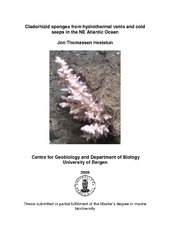| dc.contributor.author | Thomassen, Jon Hestetun | eng |
| dc.date.accessioned | 2010-05-11T07:38:54Z | |
| dc.date.available | 2010-05-11T07:38:54Z | |
| dc.date.issued | 2009-09-30 | eng |
| dc.date.submitted | 2009-09-30 | eng |
| dc.identifier.uri | http://hdl.handle.net/1956/3934 | |
| dc.description.abstract | Sponges are known to frequently contain a great number of symbiotic organisms. Symbiosis is also a characteristic trait of vent and seep animals worldwide. Sponges in the deep sea family Cladorhizidae, otherwise also known for their surprising ability to capture invertebrate prey, are among the most common sponges found in proximity to vents, and in one reported case methanotrophic symbiotic bacteria have been described in a cladorhizid species at a mud volcano. The phylogenetic relationships within the Cladorhizidae and between the cladorhizids and sister families are uncertain. New species of Cladorhizidae are still discovered, even in comparatively well studied areas such as the North Atlantic, and their affinity to vent systems make them likely candidates for harboring methanotrophic symbionts. The 2006-2009 R/V G.O. Sars" cruises to methane rich habitats in the Norwegian and Arctic Seas have yielded a number of cladorhizid specimens. This thesis contains a taxonomic inventory of these specimens using traditional morphological methods, and the results of sequencing the Folmer COI, and ITS partitions of the identified species. Lastly, the pmoA partition of the gene coding for particulate methane monooxygenase in known methanotrophic bacteria, was sequenced as a method to determine the presence of any methanotrophic symbionts from the specimens sampled. Morphological results showed that the R/V G.O. Sars" material contained six Asbestopluma and three Cladorhiza species. With the exception of two species affiliated to A. lycopodium, all were previously described species from the North Atlantic and Arctic. Though obtaining sequences proved challenging due to contamination from other organisms, cloning allowed the separation of cladorhizid and contaminant sequences, and it proved possible to get COI and ITS sequences from nearly all morphologically identified species. ITS sequences proved too divergent for phylogenetic analysis; however Folmer COI sequences had a level of resolution applicable both to place the Cladorhizidae within the broader Poecilosclerida group, close to Mycalidae, and to resolve internal relationships within the Cladorhizidae. The COI results suggest that Asbestopluma might be paraphyletic, though additional data are needed to draw more robust conclusions. Sequencing of the pmoA partition met with mixed results. It proved possible to prove the presence of the gene in small quantities in some samples, but contamination and lack of ambient controls made it difficult to draw any strong conclusions as to the origin of the sequences. | en_US |
| dc.description.abstract | Svamper er kjent for å ofte inneholde store mengder symbiotiske organismer. Symbiose er også et karakteristisk trekk ved vent- og seep-dyr fra ulike steder på jorden. Svamper fra dyphavsfmilien Cladorhizidae, ellers kjent for sin overraskende evne til å fange små evertebater, er blant de vanligste svampene i vent-nære områder, og i ett beskrevet tilfelle har metanotrofe symbiotiske bakterier blitt påvist i en cladorhizide fra en slamvulkan. Fylogenetiske forhold innad i Cladorhizidae og mellom cladorhizidene og beslektede familier er usikre. Nye arter Cladorhizidae blir fremdeles oppdaget selv i forholdsvis godt utforskede områder som i Nord-Atlanteren, og deres tilknytning til vent-systemer gjør dem til gode kandidater for påvisning av metanotrofe symbionter. Blant utbyttet av F/F «G.O. Sars»-toktene i 2006-2009 til metanrike områder i Norskehavet og Arktis finnes flere cladorhizider. Denne oppgaven inneholder en artsbestemmelse av disse prøvene ved bruk av tradisjonelle, morfologiske metoder, og resultatene fra sekvensering av Folmer COI- og ITS-partisjonene fra identifiserte arter. I tillegg ble pmoA-partisjonen av genet som koder for metan monooksygenase i kjente metanotrofe bakterier sekvensert som en metode for å påvise hvorvidt metanotrofe symbionter var tilstede i noen av prøvene. Morfologiske resultater viste at F/F «G.O. Sars»-materialet inneholdt seks Asbestopluma- og tre Cladohiza-arter. Med unntak av to sannsynlige arter knyttet til A. lycopodium, var alle prøvene tidligere beskrevne arter fra Nord-Atlanteren og Arktis. Sekvensering viste seg å være utfordrende på grunn av kontaminasjon fra andre organismer, men kloning gjorde det mulig å skille cladorhizide og andre sekvenser, og det viste seg mulig å få COI- og ITS-sekvenser fra nesten alle de morfologisk identifiserte artene. ITS-sekvensene viste seg å være for ulike for å bruke i fylogenetisk analyse, men Folmer COI-sekvensenes grad av oppløsning viste seg å være i stand til både å plassere Cladorhizidae nær Mycalidae innenfor Poecilosclerida, og vise interne forhold innad blant cladorhizidene. COI-resultatene indikerte at Asbestopluma sannsynligivs er parafyletisk. Sekvenseringen av pmoA-partisjonen ga blandede resultater. Det viste seg å være mulig å påvise små mengder av genet i noen prøver, med kontaminasjon og mangel på kontrollprøver gjorde det vanskelig å trekke noen konklusjoner angående opphavet til sekvensene. | en_US |
| dc.format.extent | 6673686 bytes | eng |
| dc.format.mimetype | application/pdf | eng |
| dc.language.iso | eng | eng |
| dc.publisher | The University of Bergen | en_US |
| dc.subject | Cladorhizidae | eng |
| dc.title | Cladorhizid sponges from hydrothermal vents and cold seeps in the NE Atlantic Ocean | en_US |
| dc.type | Master thesis | |
| dc.rights.holder | The author | en_US |
| dc.rights.holder | Copyright the author. All rights reserved | en_US |
| dc.description.degree | Master i Marin biodiversitet | en_US |
| dc.description.localcode | MAMN-MARBI | |
| dc.description.localcode | MARINDIV | |
| dc.subject.nus | 759906 | eng |
| dc.subject.nsi | VDP::Matematikk og Naturvitenskap: 400::Basale biofag: 470 | nob |
| fs.subjectcode | MARINDIV | |
